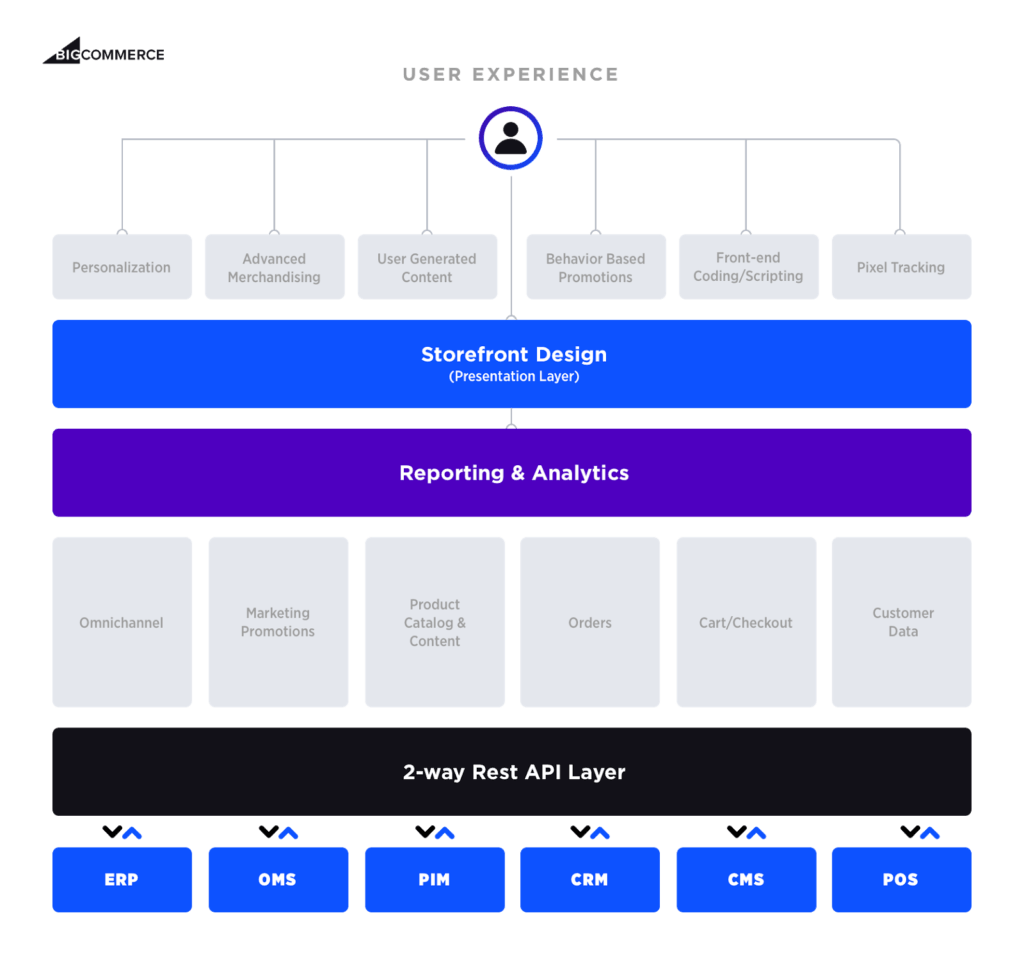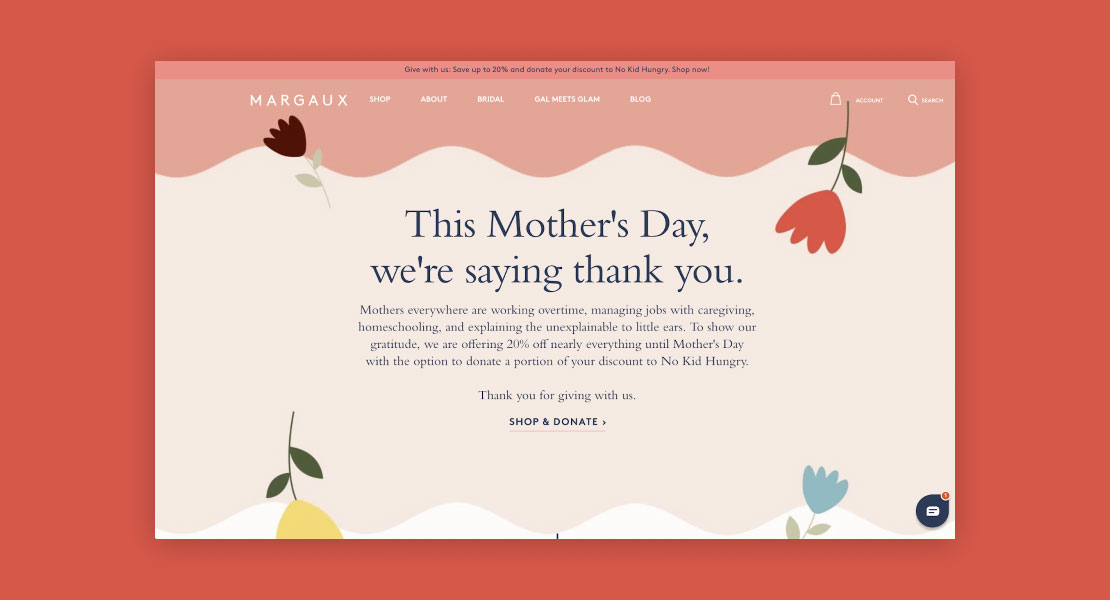What is headless commerce, and why does it matter to your business? In order to explain headless commerce, we need to establish a few important concepts first.
Headless Commerce
If you were shopping for headphones on Amazon in the year 2002, for example, as a customer, you would have been interacting with Amazon’s user interface — its buttons and symbols for navigating the site — and making a purchase. This user interface would be called the front-end platform, or the part you interact with in order to make a purchase on the site.
When you click the “purchase” button to buy your headphones, you’d be able to slide away from the computer and go make a cup of coffee, but that’s when Amazon’s work would really get going.
Amazon had an entire layer of behind-the-scenes functions that facilitated the electronic transactions, the communication to inventory, the sales registry, and many other functions necessary to make your headphones go from an online purchase mouse-click to being in a cardboard box at your door.
These functions would be called the back-end of the online commerce experience between you and Amazon. Both the front-end and back-end pages require a great deal of design and coding in order to work seamlessly. For example, if you’ve ever clicked a site button that doesn’t work, this means there’s a front-end issue going on in a site’s code.
If a change needed to be made to either the front-end or back-end functions of a site, the entire site would essentially need to be temporarily shut down so edits could be made. One could not live without the other — they were one unit.
Going Headless
Here’s where the concept of headless commerce comes in: In 2002, the front-end and back-end of Amazon’s site would have been tethered together, as explained in the scenario just above. They would have existed as a single, giant block of code, with every element touching the other.
As time has gone on, the development of API (application programming interface) technology has made it possible for one part of an e-commerce site (such as the front-end) to exist, function, and communicate with another part of that same site (such as the back-end). Thus, the back end can function and change and be developed independently of the front end, and vice versa. When a transaction is made, the APIs — think of these like digital couriers — can communicate necessary information from the front end to the back end, while remaining independent of each other.
That is “headless commerce” — the pieces work independently of each other, and the back end can function and change without having to be tethered to a certain customer-facing page.
Why Headless Commerce Matters
How does having a front-end and a back-end separated, independent, and able to communicate with APIs, make things better?
For one, it means you can shop and browse an e-commerce site without ever having to worry about slowdown or maintenance (for big sites like Amazon, anyway)! Developers might be working on a site’s inner functions without a consumer ever knowing.
Separating the two major components of an e-commerce page creates a much smoother, more adaptable, and more uniform shopping experience.
The back end still does everything it needs to do without needing to be connected to and dependent on the front end, and any necessary adjustments to either one don’t affect the real-time functioning of the other.
This means that if you’re a growing direct-to-consumer brand, you can scale design, build, and change whatever you need on your back-end, or customize and re-design your front end while keeping things separate, independent, and fully functional.
But design and customization are just the beginning of the benefits of headless commerce. When your front-end and back-end are separated, this generally improves your site’s speed, performance, and limits bugs and other negative user experiences. Headless commerce also greatly improves your site’s ability to adapt to new channels, touchpoints, third-party integrations, and APIs from other sites (think linking a calendar system to your site), and much more.
Meeting Customer Expectations
Beyond just agility and adaptability, headless commerce is important because today’s e-commerce customers expect a seamless, dazzling, uninterrupted experience when browsing or shopping. They want a rich, consistent experience across multiple devices, the ability to see customized visuals and animations, and other in-site features that require a lot of maintenance and refinement. Headless commerce makes this possible, and it’s increasingly becoming a necessity for brands that want to keep up with customer expectations.
Benefits Of Headless Commerce
What’s the outcome of “going headless”?
There are several. First, by having a true “omnichannel” experience for customers, with the ability to personalize and customize your front end to certain customer subsets, brands will see increased conversion rates and less “lead time” to create sales. This is particularly helpful as more consumers are starting/completing their shopping journey on multiple devices, making it crucial for frictionless experiences to be possible across phones, laptops, tablets, etc.
When customers don’t have to wait for a development schedule on your end and can take a look at your Halloween sale (for example) during late October, which you build as a customized interface on your site for one week, they can find an item that interests them and buy while their interest is high. Faster conversions, higher conversion rates, fewer delays, and being able to provide customers with interesting and functioning interfaces on your front end that keep them engaged are just a few of the benefits of having a flexible, headless commerce process.
And this doesn’t even mention the back-end development flexibility you’ll have to be able to isolate and work on smaller system issues without having to “open up” and work on your software as a whole — which leads to fantastic cost savings over time.
Headless Commerce By The Numbers
Headless commerce is gaining momentum in the e-commerce world, with API-driven headless commerce architecture being a top priority for brands to invest in. According to Shopify, 61% of retailers in 2020 were using or planning to use a headless platform.
But beyond the trends, the importance of website loading speeds cannot be understated. Bounce rates skyrocket as page load time increases, with 53% of shoppers abandoning a mobile site that takes more than three seconds to load. According to a Google & Deloitte joint report, every tenth of a second improvement in site speed can drive up to 10% increases in revenue.
It’s not hard to see why brands are so keen to invest and leverage headless solutions to improve online storefronts.
How To Get Started On Going Headless
Partnering with e-commerce experts who know how to build functional, adaptable, and customer-oriented pages that optimize your commerce experience is the fastest way to realize your company’s strategy. Operating a brand is complex enough, and making your website reach its potential is an entire project of its own. Thankfully, agencies like Hawke Media are here to help you get started!

Ashley Scorpio
Ashley is the Senior Vice President of Partnerships at Hawke Media




